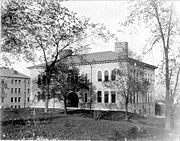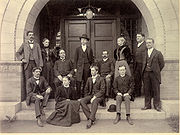
Crane Theological School
Encyclopedia

Universalist Church of America
The Universalist Church of America was a Christian Universalist religious denomination in the United States . Known from 1866 as the Universalist General Convention, the name was changed to the Universalist Church of America in 1942...
seminary at Tufts University
Tufts University
Tufts University is a private research university located in Medford/Somerville, near Boston, Massachusetts. It is organized into ten schools, including two undergraduate programs and eight graduate divisions, on four campuses in Massachusetts and on the eastern border of France...
founded in 1869 as the Tufts College Divinity School and closed in 1968. It was one of three Universalist seminaries founded in America during the nineteenth century. (The others were the Theological School of St. Lawrence University
Theological School of St. Lawrence University
The Theological School of St. Lawrence University was founded in 1856 at St. Lawrence University and closed in 1965, one of the three Universalist seminaries .-Closure:...
and the Ryder Divinity School at Lombard College
Lombard College
-History:Lombard College was founded in 1853 by the Universalist Church as the Illinois Liberal Institute. In 1855, however, a major fire damaged much of the college, placing its future at risk, but a large gift from Benjamin Lombard, an Illinois farmer and businessman, rescued the institution,...
.) During its history, it granted 281 Bachelor of Divinity degrees (some in Religious education), 152 bachelor of sacred theology degrees, and two masters of religious education—a total of 435 degrees.
The name changed on multiple occasions: it was founded as "Tufts College Divinity School" renamed to "Crane Theological School" in 1906 upon Albert Crane's gift of $100,000 in 1906 in honor of his father Thomas Crane. In 1925 the school became officially the "Tufts College School of Religion – Crane Theological School," after extensive discussions, including a conference with the widow of Albert Crane. By the 1960s, the name had shortened simply to "Crane Theological School" by the 1960s. The Crane Building on the Tufts campus still carries the name.
It was one of the Associated Schools of the Faculty of Arts and Sciences from 1903–1962 and 1965–1968. The school was never officially denominationally controlled, nor was it accredited by the American Association of Theological Schools.
Founding – World War I

The divinity school was initially housed in Ballou Hall, in a room on the second floor. With the construction of West Hall in 1872, divinity students were offered accommodation there. 1891 saw the building of separate quarters for the school with the construction of Miner and Paige halls. Miner Hall was built to provide classroom and office space for the school while Paige Hall served as a dormitory and chapel.
Miner Hall was constructed in 1891 to serve as headquarters for the School of Theology. It was named for Alonzo A. Miner, second president of Tufts College and the major donor to the project ($40,000).
Paige Hall was built in 1892 to serve as a dormitory for Theological School Students. Named for Lucius R. Paige, Universalist minister and trustee 1859–1896.
In 1902, a combined 5-year AB/STB began to be offered.
Between 1910 and 1915, both Miner and Paige halls were taken over by the newly established Jackson College for Women
Tufts University
Tufts University is a private research university located in Medford/Somerville, near Boston, Massachusetts. It is organized into ten schools, including two undergraduate programs and eight graduate divisions, on four campuses in Massachusetts and on the eastern border of France...
, until women were integrated into the rest of Tufts in 1915 and the facilities were turned back over to the Crane School.
WWI

In 1929 the Crane chapel was built as an addition to the Crane building (the two-level Fischer arcade connecting it to Miner was also built at this time). The architects were George, Lloyd and Ruffing. Designed as an adaptation of a chapel in Oxford, England, the oak paneling was brought from Warwick Forest in England.
Postwar
By 1945 and Skinner's retirement, the school had almost no endowment, only one full-time and one half-time faculty member and a number of part-time teachers who taught one course per year. In 1949, dean Ratcliff was able to add only one more full-time faculty member. After the 1951 destruction by fire of Fisher Hall, the main building of the Universalist St. Lawrence Theological School, Ratcliff favored merging the two schools. St. Lawrence voted instead to rebuild Fisher Hall. When Tufts in 1952 initiated a major fund raising drive to celebrate its second century, it completely ignored the needs of the School of Religion. The School, therefore, launched its own $250,000 fund drive. Universalist donors were unable to meet this goal.Ratcliff and Tufts president Leonard Carmichael
Leonard Carmichael
Leonard Carmichael was a U.S. educator and psychologist. Born on November 9, 1898 in Philadelphia, Pennsylvania, he received his B.S. from Tufts University in 1921 and his Ph.D. from Harvard University in 1924...
disagreed over fundamental policy. Carmichael felt that the School of Religion should be a professional graduate school, admitting only students with an undergraduate degree. Ratcliff favored continuing to allow undergraduates to work for a combined A.B. and S.T.B.
Bachelor of Sacred Theology
The Bachelor of Sacred Theology is a graduate-level academic degree in theology.The Bachelor of Sacred Theology is offered by a number of Pontifical Universities. It is sometimes offered as a graduate degree, for students who have already completed a B.A. or other first degree...
degree and admitting students who wished to pursue religious studies, regardless of their academic background or professional potential. In the end Carmichael's vision prevailed and Ratcliff started the process to convert the Tufts School of Religion into a fully academic graduate school. He did not live to oversee this transformation. After a brief illness he died at the age of sixty.
In 1962, Crane disassociated itself from the faculty of arts and sciences to report directly to the trustees. The intention was to become a fully independent graduate school. Resources were inadequate for even a quasi-independent existence, and in 1965 the faculties were recombined. The plan was for an undergraduate degree to be a requirement for admission and for the combined AB/STB program to be phased out.
Closing
In 1953, when Dean Ratcliff died unexpectedly, Eugene Ashton, a congregational minister and assistant chaplain of Tufts, was appointed to replace him until a successor could be found. Shortly before his successor's appointment in 1954, Ashton released a report on the school, arguing that it was "not in a particularly healthy state". He observed that of 151 men enrolled between 1947 and 1952, 80 were non-graduates; of the 33 women who attended during the same period, 14 were non-graduates.The AUA Board of Trustees in 1959 appointed a commission to study theological education in anticipation of merger with the Universalists. In 1962 the report advocated the merger of St. Lawrence and Crane, and a 1964 GA resolution was discussed advocating a merger with Star King or Meadville. Neither attempt was successful. The lack of funds to continue operation was the main reason for closing Crane. The school had run in deficit for a number of years—in 1964 half of the $90,000 Crane budget had to be paid out of Tufts general operating fund.
The decision to close the school was reached by the trustees in June 1967, to take place the following year. A number of factors contributed to the decision. The committee that recommended closure gave financial reasons as the primary reason for closure—they estimated $250K per year would have been required to operate the school, and had no way to pay for it, as the Tufts operating deficit in 1967 was more than $500K. However, the trustees' June 1967 recommendation for closure cited that the school had not "maintained its place of considerable distinction in theological education."
Tufts President Hallowell was given authority by State court to disposition school funds, and created the Crane Program fund amounting to $213K in 1972 to support the Religion department, the Chaplaincy, and scholarships for Tufts students pursuing liberal ministry and social welfare work. The Crane Library Collection was transferred to Harvard Divinity School in 1975.
Deans
All of Crane's deans were Universalist clergy.- 1869–1891, Thomas Jefferson Sawyer
- 1891–1910, Charles Hall Leonard (second dean)
- 1912–1933, Lee Sullivan McCollester
- 1933–1945, Clarence SkinnerClarence Skinner (minister)Clarence Russell Skinner was a Universalist Minister, Teacher, and Dean of the Crane School of Theology at Tufts University. Born in Lexington, Massachusetts. He wrote several books that had a substantial influence on Universalism in America in the twentieth century: The Social Implication of...
. - 1945–1953, John Moses Ratcliff
- 1953, Eugene S. Ashton (acting Dean after Ratcliff's unexpected death)
- 1953–1967, Benjamin Butler Hersey
Enrollment

- 1869: 4 students
- 1871: 12 Students
- 1892: 44 students
- 1906: 9 students
- 1910: 15 students
- 1912: 4 students
- 1923: 24 students
- 1928: 36 students
- 1937: 60 students
- 1955: 31 students
- 1957: 22 students
- 1959: 21 students
- 1960: 20 students
- 1968: 12 students
In the period between 1947 and 1952, 151 men were enrolled, on 71 of whom completed a degree. Similarly, 33 women were enrolled on 19 of whom completed a degree.

